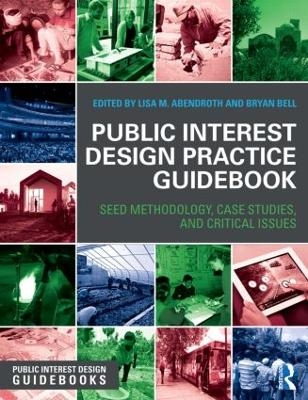
Public Interest Design Practice Guidebook
Routledge (Verlag)
978-1-138-81035-8 (ISBN)
Contributions from Thomas Fisher, Heather Fleming and David Kaisel, Michael Cohen, Michael P. Murphy Jr. and Alan Ricks, and over twenty others cover topics such as professional responsibility, public interest design business development, design evaluation, and capacity building through scaling, along with many more. Themes including public participation, issue-based design, and assessment are referenced throughout the book and provide benchmarks toward an informed practice. This comprehensive manual also contains a glossary, an appendix of engagement methods, a case study locator atlas, and a reading list. Whether you are working in the field of architecture, urban planning, industrial design, landscape architecture, or communication design, this book empowers you to create community-centered environments, products, and systems.
Lisa M. Abendroth is a professor at Metropolitan State University of Denver in Colorado, USA. She is a SEED Network founding member, a SEED Evaluator coauthor, and a 2013 recipient of the SEED Award for Leadership in Public Interest Design. Bryan Bell is the founder of Design Corps in North Carolina, USA, and cofounder of the SEED (Social Economic Environmental Design) Network. Bell was awarded a National AIA Award and was a National Design Award Finalist. His work has been exhibited at the Venice Biennale and the Cooper Hewitt, Smithsonian Design Museum.
Acknowledgements. Foreword Scott Moore y Medina, Jon Red Corn. Introduction. Part 1: Understanding Public Interest Design: Essays 1. The State of Public Interest Design Bryan Bell 2. What Social Justice Movements Can Teach Us About Public Interest Design Barbara Brown Wilson 3. Professional Responsibility and Ethics Thomas Fisher 4. Learning From Public Interest Practices Roberta Feldman, Sergio Palleroni, David Perkes 5. Designers Engaging in Business Development Heather Fleming, David Kaisel 6. Evaluating Impact Without Evidence Michael A. Cohen 7. Post Occupancy: Implementation and Evaluation Steven A. Moore Part 2: Practicing Public Interest Design: SEED Methodology 8. Social Economic Environmental Design Methodology 9. The SEED Evaluator and SEED Certification 10. Starting a Project: Public Participation and the Feedback Loop 11. Moving Forward Together: Engagement in Community Design and Development Ceara O'Leary, Dan Pitera 12. Paths to a Sustainable Future: Native American Community Building Jamie Blosser 13. Sustaining Collaboration: Extended Engagement 14. Storytelling for Social and Environmental Impact in Design Michael Haggerty 15. Amplifying Community Voice: Neighborhood Identity Development Brent A. Brown, Emily Schmidt 16. Doing More: Issue-Based Design and the Triple Bottom Line 17. Unthinking Sanitation for the Urban Poor Julia King, Dr. Renu Khosla 18. A Balanced Approach to the Demand for Classrooms Margarette Leite, Sergio Palleroni 19. Assessing Results: Defining and Measuring Success 20. Designing Solutions to Childhood Malnutrition Ramsey Ford, Kate Hanisian 21. Setting the Stage for Social, Economic and Environmental Achievement: Benchmarking the Durham Performing Arts Center Philip Szostak 22. Scaling a Project: Uniting Diverse Stakeholders 23. Lessons from Rwanda: Scaling Up Holistic Approaches to Health Facilities Michael P. Murphy Jr., Alan Ricks, Annie Moulton 24. Evolving the Sanitation Marketplace in Cambodia Yi Wei Part3: Documenting the Value of Public Interest Design: Case Studies and Issues Index 25. The Issues Index: Expanded Opportunity Through an Issues Approach 26. Case Studies and Issues Index. Glossary. Contributors Biographies. Reading List. Appendix A: Methods of Engagement. Appendix B: Issue Index Cross-Reference Guide. Appendix C: Case Study Locator Map. Image Credits. Index
| Reihe/Serie | Public Interest Design Guidebooks |
|---|---|
| Zusatzinfo | 12 Line drawings, color; 187 Halftones, color |
| Verlagsort | London |
| Sprache | englisch |
| Maße | 189 x 246 mm |
| Gewicht | 1043 g |
| Themenwelt | Kunst / Musik / Theater ► Design / Innenarchitektur / Mode |
| Naturwissenschaften ► Biologie ► Ökologie / Naturschutz | |
| Technik ► Architektur | |
| Wirtschaft ► Betriebswirtschaft / Management ► Projektmanagement | |
| ISBN-10 | 1-138-81035-5 / 1138810355 |
| ISBN-13 | 978-1-138-81035-8 / 9781138810358 |
| Zustand | Neuware |
| Haben Sie eine Frage zum Produkt? |
aus dem Bereich


